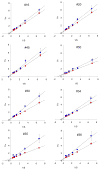Functionalized carbon nanotubes specifically bind to alpha-chymotrypsin's catalytic site and regulate its enzymatic function
- PMID: 19408924
- PMCID: PMC2814308
- DOI: 10.1021/nl900437n
Functionalized carbon nanotubes specifically bind to alpha-chymotrypsin's catalytic site and regulate its enzymatic function
Abstract
Although carbon nanotubes (CNTs) have been shown to nonspecifically bind proteins through charge complementary, pi-pi stacking or hydrophobic interactions, they have not been shown to bind to a specific site on proteins. By generating surface molecular diversity, we created functionalized CNTs that recognize and bind to the catalytic site of alpha-chymotrypsin and inhibit its enzymatic activity competitively.
Figures





References
Publication types
MeSH terms
Substances
Grants and funding
LinkOut - more resources
Full Text Sources
Research Materials
Miscellaneous

